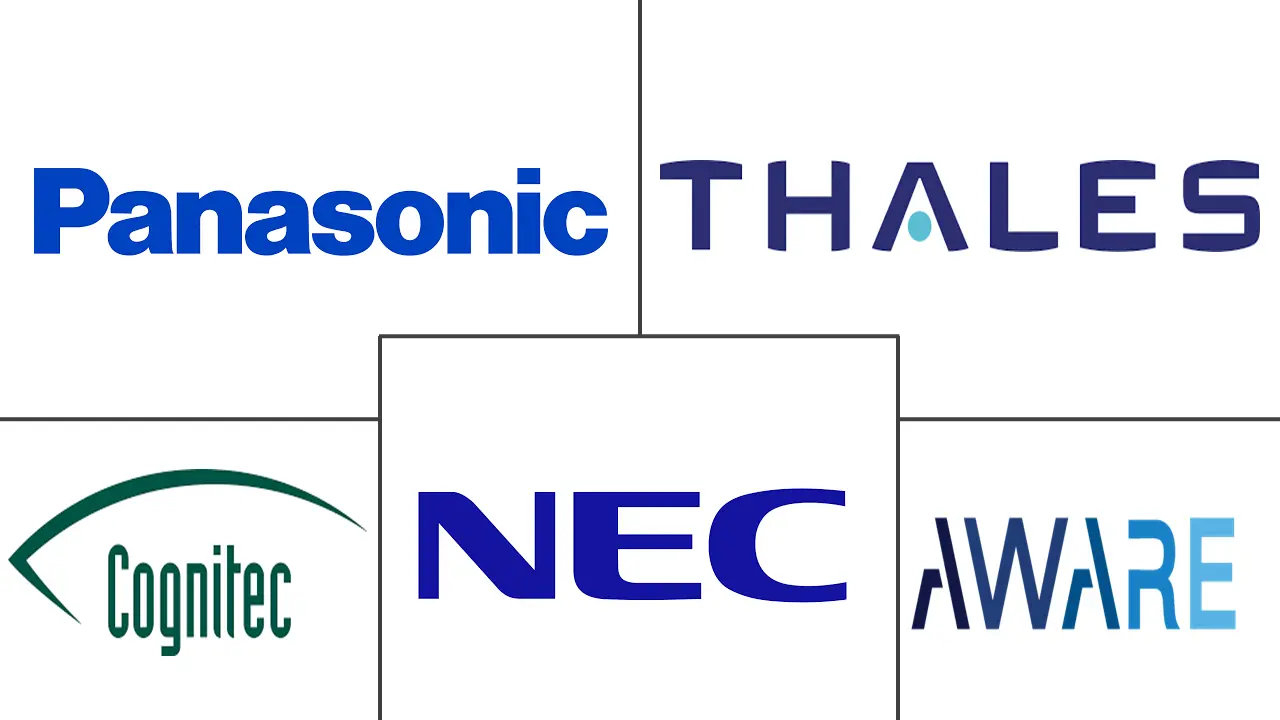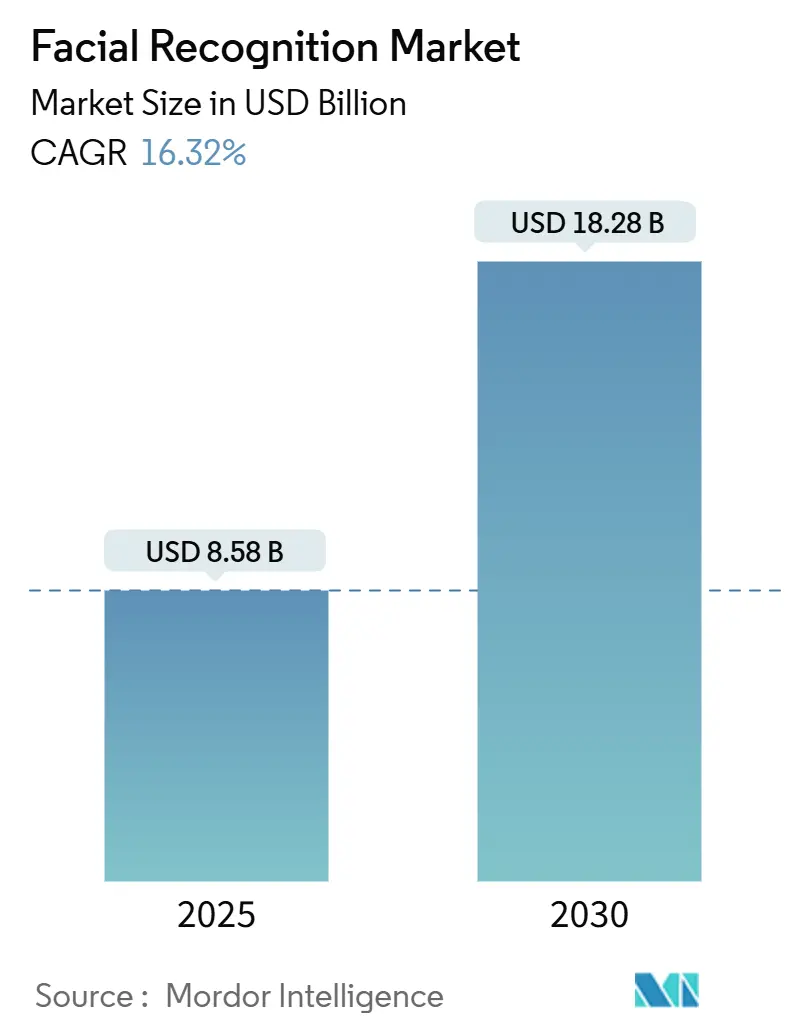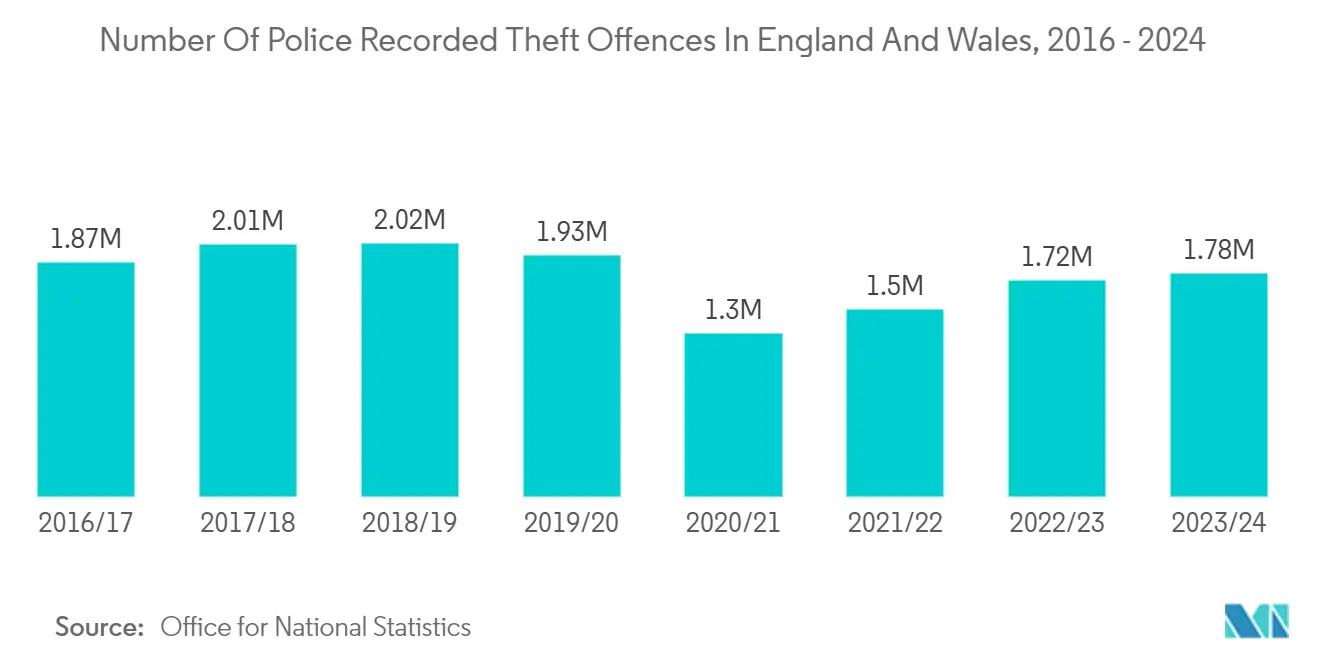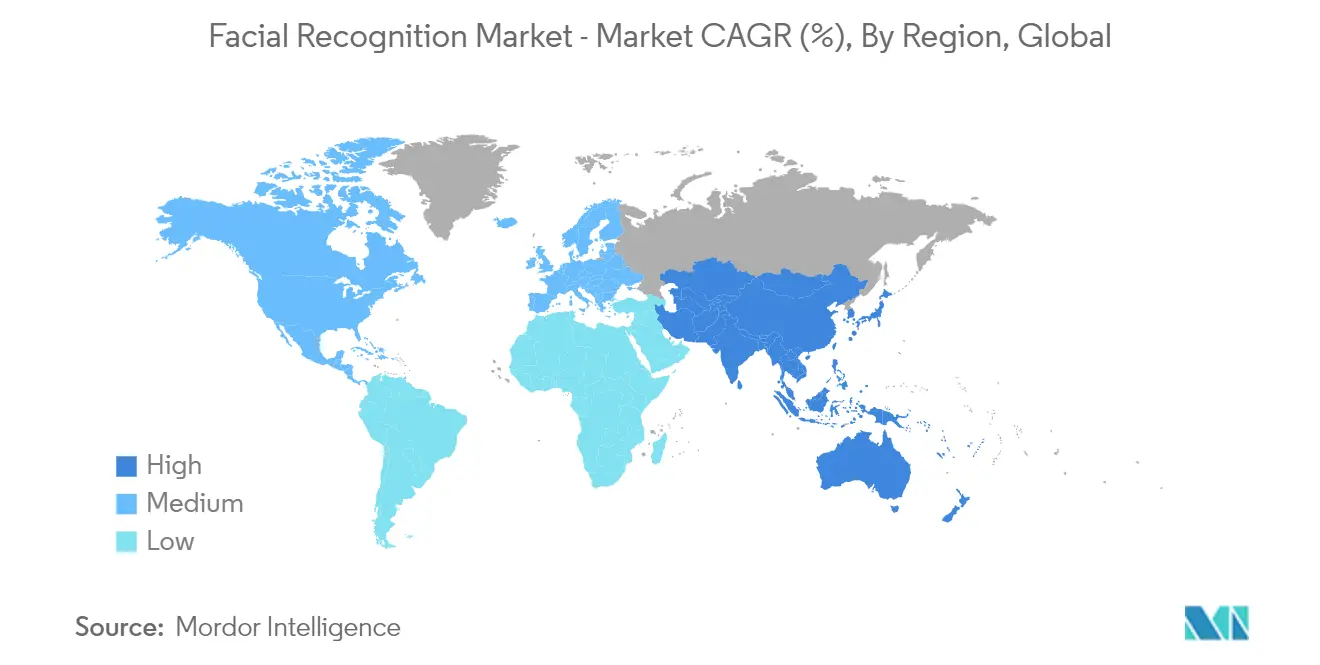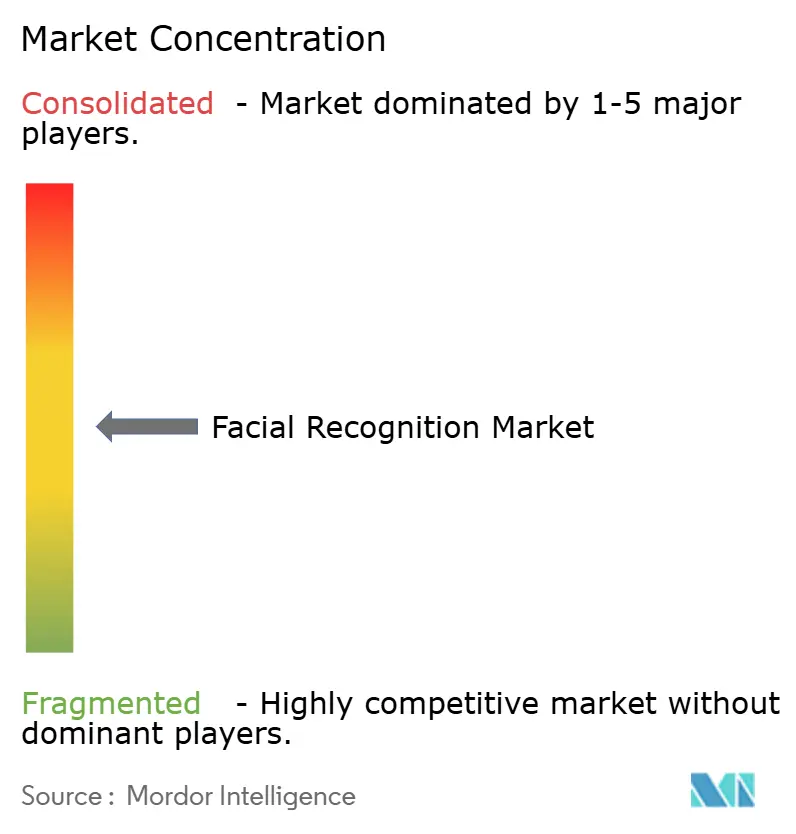Facial Recognition Market Analysis
The Facial Recognition Market size is estimated at USD 8.58 billion in 2025, and is expected to reach USD 18.28 billion by 2030, at a CAGR of 16.32% during the forecast period (2025-2030).
- Facial recognition is swiftly emerging as the go-to method for authentication, thanks to its convenience, robust security, and seamless integration capabilities. This technology is increasingly supplanting traditional passwords and PINs across a myriad of applications, from unlocking devices to validating identities in financial transactions and access control. The heightened security offered by facial recognition is fueling its rising demand. For example, by leveraging unique biometric data—specifically facial features—facial recognition provides a level of verification that's notably harder to impersonate or breach than conventional passwords or PINs.
- Advancements in algorithms, easier access to facial data, and heightened demand from governments and businesses for security and identification are propelling the rapid growth of facial recognition technology in surveillance systems. Security cameras, now equipped with facial recognition, can pinpoint and monitor individuals in real-time across public spaces, airports, and more. Both governments and businesses are turning to facial recognition for purposes ranging from security and border control to criminal investigations. As security concerns rise globally, the adoption of facial recognition technology is set to surge, fueling market growth.
- Furthermore, facial recognition technology is rapidly gaining traction in consumer electronics, primarily due to its dual benefits of bolstering security and enhancing user convenience. Applications range from device unlocking and authentication to facilitating mobile payments, all contributing to a projected surge in the market. Notably, the ability to unlock devices is a significant driver of this demand. Widely adopted for smartphones and other gadgets, facial recognition offers a seamless and secure alternative to traditional passwords and PINs. Furthermore, ongoing technological advancements are poised to further accelerate this market's growth.
- However, facial recognition technology is under scrutiny for its privacy implications. Concerns range from its potential for mass surveillance and misuse of biometric data to issues of transparency and algorithmic bias, which can lead to discrimination. Oloid.ai highlights that a primary worry with facial recognition is its capacity for mass surveillance. Such systems can monitor individuals in public spaces, often without their awareness or consent, fostering a pervasive sense of being watched. This not only infringes on individual privacy but can also stifle free expression, breed distrust, and pave the way for discrimination and power abuses.
- As economies strengthen, investments in AI and security technologies surge. This economic upswing boosts the facial recognition market, channeling funds into security, infrastructure, and tech. This influx not only accelerates adoption but also propels growth in surveillance, access control, and financial sectors. By 2025, while nations like India and South Korea are witnessing economic growth, Germany grapples with subdued growth predictions. Furthermore, government spending and increased public sector investments in surveillance, border control, and other sectors will enhance the market opportunities.
Facial Recognition Market Trends
Security and Law Enforcement Holds Significant Market Share
- Advanced networks equipped with multi-directional cameras, combined with the advancements in commercial AI systems, are enabling the complete replacement of traditional facial security systems.
- Panasonic's FacePRO facial recognition system utilizes face matching and search capabilities to identify challenging faces with the support of standard video surveillance technology. Globally, prominent technology vendors are increasingly restricting the use of their facial recognition technologies by law enforcement agencies. Advances in matching algorithms and neural networks have significantly enhanced facial recognition capabilities, contributing to efforts to prevent terrorist activities.
- Advancements in algorithms, easier access to facial data, and heightened demand from governments and businesses for security and identification are propelling the rapid growth of facial recognition technology in surveillance systems. Security cameras, now equipped with facial recognition, can pinpoint and monitor individuals in real-time across public spaces, airports, and more. Both governments and businesses are turning to facial recognition for purposes ranging from security and border control to criminal investigations. As security concerns rise globally, the adoption of facial recognition technology is set to surge, fueling market growth.
- Law enforcement agencies worldwide are increasingly turning to facial recognition technology in surveillance systems to enhance crime-fighting efforts and bolster security measures. Countries around the globe are wrestling with diverse criminal challenges, from violent and organized crime to drug-related offenses, with certain regions experiencing heightened insecurity. For example, data from the Office for National Statistics reveals that in 2023/24, England and Wales recorded the highest crime rate in the UK, tallying 89.7 crimes for every 1,000 individuals. Additionally, police forces in England and Wales documented roughly 1.77 million theft offenses in 2023/24, a rise from just under 1.72 million in the prior year.
North America Holds Largest Market Share
- North America is anticipated to hold a significant share of the facial recognition market, driven by increasing demand for the technology in homeland security and criminal investigations.
- The US government has adopted Amazon’s facial recognition technology to enhance security measures. The rise in terrorist activities in recent years has prompted governments in the region to implement comprehensive physical security strategies.
- The FBI operates the largest facial recognition surveillance system in the United States, maintaining a database with images of over 117 million Americans. On average, the FBI conducts 4,055 searches per month using facial recognition systems. Furthermore, the US Customs and Border Protection utilizes a facial recognition system to identify and intercept criminals and terrorists at the border.
- This biometric system compares travelers’ facial features with their passport photos, highlighting the region's strong growth potential in the facial recognition market.
Facial Recognition Industry Overview
In a landscape dominated by major players, facial recognition providers grapple with intense competition. As market dynamics shift, these companies intensify their efforts to remain pertinent. They actively forge alliances and participate in working groups, keeping a pulse on industry trends and technological advancements.
In the moderately competitive facial recognition market, established players such as Panasonic Corporation, Thales Group, NEC Software Solutions UK Limited (a subsidiary of NEC Corporation), Cognitec Systems GmbH, and Aware, Inc. are taking the lead. Notably, some of these players also have stakes in hardware and network infrastructure. Meanwhile, a host of startups are fiercely competing for market share, fueling both innovation and strategic partnerships.
Market vendors are increasingly targeting local enterprises across various regions, not just to bolster their regional presence but also to tap into datasets reflecting regional biological features. Additionally, as government surveillance contracts often lean towards local enterprises, major market vendors are anticipated to pursue partnerships, joint ventures, and acquisitions.
In a bid to seize growth opportunities and solidify their market stance, companies are expanding their product portfolios and engaging in mergers and acquisitions. For instance, in October 2024, Clear, renowned for expediting airport processes, is eyeing the healthcare sector for its facial recognition technology.
Established tech giants, leveraging their existing business relationships, distribution channels, and supply chain insights, enjoy a competitive edge over newcomers in the market. Moreover, companies are continuously innovating, pouring investments into R&D to enhance accuracy, speed, and adaptability across diverse applications.
With rising market awareness and AI becoming mainstream, companies at various tiers of AI solution provision are gradually making their foray into the market. Thus, the degree of competitive rivalry in the market studied is moderately high over the forecast period.
Facial Recognition Market Leaders
-
Panasonic Corporation
-
Thales Group
-
NEC Software Solutions UK Limited (NEC Corporation)
-
Cognitec Systems GmbH
-
Aware, Inc.
- *Disclaimer: Major Players sorted in no particular order
Facial Recognition Market News
- February 2025: BigBear.ai, a prominent provider of AI-driven decision intelligence solutions across sectors such as defense and national security, announced a collaboration with SoftPoint. Through SoftPointPay, BigBear.ai's Trueface facial biometric solutions will now secure consumer payment transactions across SoftPoint's extensive retail network. This integration is expected to provide businesses with enhanced security measures, streamlined operations, and improved customer satisfaction in payment processes.
- September 2024: NEC Corporation unveiled a state-of-the-art biometric system, enabling facial recognition authentication for individuals on the move. This innovation caters to the growing demand in bustling venues like airports. As per the company's announcement, the system boasts an impressive capacity, authenticating up to 100 individuals every minute. Moreover, the advanced facial recognition system is designed to factor in movement patterns and clothing traits. Overhead displays of the system generate visual alerts, drawing immediate attention to unauthorized attempts. Additionally, the system integrates seamlessly with AR glasses and projection mapping systems. According to NEC, the system boasts minimal hardware requirements, needing just a single camera and a compact “palm-sized” edge terminal for implementation.
Facial Recognition Industry Segmentation
The market is defined by the revenue generated from the sale of facial recognition solutions globally.
The facial recognition market is segmented by technology (2d facial recognition, 3d facial recognition, and facial analytics), application (access control, security and surveillance, and other applications), end user (security and law enforcement, healthcare, retail and e-commerce, BFSI, automobile and transportation, telecom and it, media and entertainment, and other end users), and geography (North America, Europe, Asia-Pacific, Latin America, and Middle East and Africa). The market sizes and forecasts are provided in terms of value (USD) for all the above segments.
| By Technology | 3D Facial Recognition |
| 2D Facial Recognition | |
| Facial Analytics | |
| By Application | Access Control |
| Security and Surveillance | |
| Other Applications | |
| By End User | Security and Law Enforcement |
| Healthcare | |
| Retail and E-commerce | |
| BFSI | |
| Automobile and Transportation | |
| Telecom and IT | |
| Media and Entertainment | |
| Other End Users | |
| By Geography*** | North America |
| Europe | |
| Asia | |
| Australia and New Zealand | |
| Latin America | |
| Middle East and Africa |
| 3D Facial Recognition |
| 2D Facial Recognition |
| Facial Analytics |
| Access Control |
| Security and Surveillance |
| Other Applications |
| Security and Law Enforcement |
| Healthcare |
| Retail and E-commerce |
| BFSI |
| Automobile and Transportation |
| Telecom and IT |
| Media and Entertainment |
| Other End Users |
| North America |
| Europe |
| Asia |
| Australia and New Zealand |
| Latin America |
| Middle East and Africa |
Facial Recognition Market Research FAQs
How big is the Facial Recognition Market?
The Facial Recognition Market size is expected to reach USD 8.58 billion in 2025 and grow at a CAGR of 16.32% to reach USD 18.28 billion by 2030.
What is the current Facial Recognition Market size?
In 2025, the Facial Recognition Market size is expected to reach USD 8.58 billion.
Who are the key players in Facial Recognition Market?
Panasonic Corporation, Thales Group, NEC Software Solutions UK Limited (NEC Corporation), Cognitec Systems GmbH and Aware, Inc. are the major companies operating in the Facial Recognition Market.
Which is the fastest growing region in Facial Recognition Market?
North America is estimated to grow at the highest CAGR over the forecast period (2025-2030).
Which region has the biggest share in Facial Recognition Market?
In 2025, the North America accounts for the largest market share in Facial Recognition Market.
What years does this Facial Recognition Market cover, and what was the market size in 2024?
In 2024, the Facial Recognition Market size was estimated at USD 7.18 billion. The report covers the Facial Recognition Market historical market size for years: 2019, 2020, 2021, 2022, 2023 and 2024. The report also forecasts the Facial Recognition Market size for years: 2025, 2026, 2027, 2028, 2029 and 2030.
Our Best Selling Reports
Facial Recognition Industry Report
The Global Facial Recognition Market is on a rapid growth trajectory, fueled by escalating security needs and the demand for efficient surveillance across various sectors, including airports, critical infrastructure, and public spaces. This surge is propelled by the adoption of facial recognition technology in mobile devices for enhanced authentication, finding applications in finance, healthcare, education, and retail to streamline operations and secure transactions. Despite facing challenges like privacy issues and the threat of hacking, continuous innovations by top facial recognition companies are paving the way for more secure solutions. The Asia Pacific region is leading the growth, driven by technological advancements and a focus on modernization, especially in government applications to boost public safety. As the market expands, highlighted by Mordor Intelligence™ Industry Reports, which offer a comprehensive analysis and forecast, it's imperative to ensure the ethical use of this technology by balancing its benefits with privacy safeguards. Get insights into the market's size, share, and revenue growth, along with a historical overview, by downloading a free report PDF sample.

